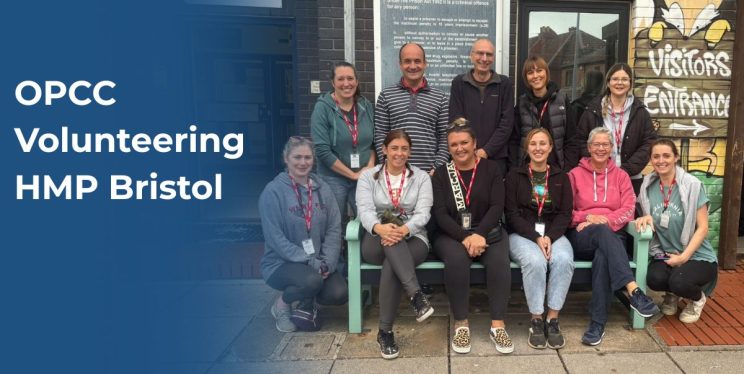Painting a Different Picture: Our Volunteer Day at HMP Bristol

By Jenny Griffiths, Justice Board Coordinator, OPCC
Walking through the gates of HMP Bristol for our OPCC volunteer day, I wasn’t quite sure what to expect. We were there to help paint a mural inside the prison, a project designed by one of the prisoners who had already stencilled the outlines and would be guiding us as we brought it to life with colour. It was an opportunity not just to volunteer, but to see firsthand the human side of the justice system, something that is easy to overlook when most of our work happens outside the prison walls.
Deputy Governor Natalie Steadman explained that one of the prison’s aims is to open up the space to visitors and organisations like ours, helping people better understand what life inside is really like. Too often, the justice system is seen as ending at the court stage, but prisons play a vital role in rehabilitation and in preparing people to return to their communities. The visit was a reminder that those in custody are still members of society and that supporting their reintegration benefits everyone.
It was notable to see how much effort is going into helping prisoners develop skills and confidence for life after release. One of the programmes on offer is a Stoicism course, which encourages reflection on what individuals can and cannot control, and helps them to manage their emotions and responses to difficult situations.
For me, the most interesting stop on our visit was the Textile Shop. HMP Bristol produces tens of thousands of bed sheets and pillowcases every year for the national prison estate. Debbie, who manages the workshop, has been there for 35 years and spoke about how rewarding it is to see people gradually gain confidence in their abilities. Many of the men begin with little interest in sewing, but over time some ask to learn more and develop new skills, small steps toward self-belief and independence.
When we began the mural painting, we worked alongside six men from the Incentivised Substance-Free Living (ISFL) wing, which focuses on tackling drug misuse in prisons. Many spoke about how the support they receive helps them to better understand themselves and their behaviours. Several reflected on the difference that sustained support in the community could make, particularly for those returning to rural areas where services can be limited. Others felt that prison had given them the opportunity and motivation to access help they had not engaged with before.
Despite the serious themes we discussed, the day included moments of light conversation. We compared favourite restaurants, shared local recommendations, and swapped stories about hobbies and experiences. One of the men told me about his time clay pigeon shooting, giving me tips for when I finally try it myself.
Another conversation that stood out was about mental health. One of the men shared his own experience, which was similar to my own. It reminded me that while prisons can seem like remote and intimidating places, many of the people inside are dealing with the same challenges as the rest of us, but with different support networks.
As someone who is not naturally confident with a paintbrush, I worried about making mistakes or getting things wrong, but the day was about contributing where I could.
By the end of the day, the mural was taking shape, a vibrant and meaningful piece of art created through collaboration and conversation. More importantly, we had learned something about empathy, rehabilitation, and the importance of understanding what life inside the prison is really like.
I left HMP Bristol reminded that rehabilitation is not an abstract concept. It is built through moments like these, through creativity, learning, and shared understanding.
